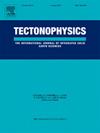Unraveling the geological history of the South Atlantic margin: Records of West Gondwana Breakup from South Brazil and Uruguay margin
IF 2.7
3区 地球科学
Q2 GEOCHEMISTRY & GEOPHYSICS
引用次数: 0
Abstract
Continental Flood Basalts, Seaward Dipping Reflectors (SDRs), and oceanic plateaus or seamounts often occur in close geographic proximity. In South America, the Paraná-Etendeka Continental Flood Basalts are followed by SDR-related magmatism, and even after the formation of oceanic crust, anomalous magmatism persists in the region, as seen in the Walvis Ridge and Rio Grande Rise. This study investigates volcanic and sedimentary rocks from offshore wells in the Pelotas and Punta del Este basin margins, revealing the offshore extension of the Paraná Basin. Our data demonstrate geochemical and isotopic affinities between margin volcanic rocks and the Paraná-Etendeka Large Igneous Province. The basalts from the margin display OIB- and E-MORB-like geochemical and isotopic compositions consistent with EMI and EMII mantle sources. However, these isotopic signatures may have been modified by assimilation of continental crust or subcontinental lithospheric mantle. The presence of zircon xenocrysts support this interpretation, and suggests that volcanic rocks from the margin were emplaced above the continental crust with magmatic assimilation of rocks from Dom Feliciano Belt. The Rio Grande Rise also exhibits an EMI-like isotopic fingerprint similar to the Walvis Ridge, indicating a possible shared origin during the Cretaceous. However, this isotopic content may also result from magmatic assimilation of continental crust slivers or subcontinentallithospheric mantle. These findings highlight the role of a persistent thermal anomaly throughout the magmatic evolution of the South Atlantic.
揭示南大西洋边缘的地质历史:巴西南部和乌拉圭边缘的西冈瓦纳分裂记录
大陆泛洪玄武岩、向海倾斜反射岩(sdr)和海洋高原或海山经常发生在地理上接近的地方。在南美洲,Paraná-Etendeka大陆泛洪玄武岩之后是与sdr相关的岩浆活动,即使在洋壳形成之后,该地区仍然存在异常岩浆活动,如Walvis Ridge和里约热内卢Grande Rise。本研究调查了Pelotas和Punta del Este盆地边缘海上油井的火山岩和沉积岩,揭示了paran盆地的海上延伸。我们的数据证明了边缘火山岩与Paraná-Etendeka大火成岩省之间的地球化学和同位素相似性。边缘玄武岩的地球化学和同位素组成与EMI和EMII地幔源一致,具有OIB和e - morb类特征。然而,这些同位素特征可能受到大陆地壳或次大陆岩石圈地幔同化作用的改变。锆石异种结晶的存在支持了这一解释,并表明来自边缘的火山岩是在Dom Feliciano带岩石的岩浆同化作用下置于大陆地壳之上的。里约热内卢大隆起也显示出类似于沃尔维斯山脊的emi样同位素指纹,表明在白垩纪时期可能有共同的起源。然而,这种同位素含量也可能是大陆地壳碎屑或次大陆岩石圈地幔岩浆同化的结果。这些发现强调了在南大西洋岩浆演化过程中持续的热异常的作用。
本文章由计算机程序翻译,如有差异,请以英文原文为准。
求助全文
约1分钟内获得全文
求助全文
来源期刊

Tectonophysics
地学-地球化学与地球物理
CiteScore
4.90
自引率
6.90%
发文量
300
审稿时长
6 months
期刊介绍:
The prime focus of Tectonophysics will be high-impact original research and reviews in the fields of kinematics, structure, composition, and dynamics of the solid arth at all scales. Tectonophysics particularly encourages submission of papers based on the integration of a multitude of geophysical, geological, geochemical, geodynamic, and geotectonic methods
 求助内容:
求助内容: 应助结果提醒方式:
应助结果提醒方式:


